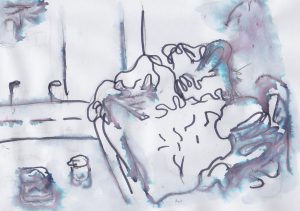
Does your ‘masculinity’ need to seduce me?
by Tony Wilkes | April 10, 2018
‘That one.’
‘Straight.’
‘Really?’
‘Yeah.’
‘Damn.’
I’m sitting in the smoking area of a club. I’m surrounded by a mash-up of oversized shirts, denim, fine-artists, dramatists, bob-cuts, and dope.
‘But he’s coming over.’
Amid empty benches, he sits beside me. I notice our legs touch. He hangs his face so close that I could draw the outline of his lip. He speaks maintaining eye contact. He’s unravelling my eyes; a kind of striptease. This isn’t the first time.
Straight men are buying me drinks. I’m leaving clubs having only paid entrance. Recently I’ve had whispered in my ear: ‘You could get with five guys here.’ How he calculated five I don’t know but I’ll take it. The Huffington Post ran a story: ‘Beware the flirtatious straight man – six types to look out for.’ This includes “Mr Bored” who just “wants to try something ‘new’.” A gay columnist for GQ, Justin Myers, writes: “[it’s] always been there – the invention of ecstasy and house music has seen to it that the lines are blurrier than ever.”
But these fault lines don’t only run along sexual preference. The line between straight and gay men also marks out conceptions of gender. Being gay blurs the line between what is thought of as ‘masculine’ and ‘feminine’. The philosopher Judith Butler famously reconceptualised gender studies in the ‘90s with her book Gender Trouble. The argument is: ‘masculine’ and ‘feminine’ are not what we are, but the effect of things we do. So ‘to be a man’, I must perform. I must act like one. The minimal requirement for ‘being a man’ – to be obvious – is ‘not being a woman.’ But gay men cross this line by performing an overwhelmingly feminine act – we desire men.
This is the reason why the word ‘gay’ is now synonymous with failing to measure up to a certain standard of ‘masculinity’. This is why sexless objects, even concepts, like clothes, drinks, mannerisms, can all be gay. This is why according to my driving instructor (guys watch out), a Fiat 500 is gay. It’s also why the common response I get when I tell people my sexuality is ‘I never would have thought.’ And in an awful way, this reassures me: it shows I’m succeeding in ‘being a man’.
Homophobia, it has been found, is in many ways a defence from this subversion of ‘masculinity’. One sociologist argues in The Sociological Quarterly (1990) that “homophobia…may serve to protect our society’s gender definition.” It follows that studies undertaken by psychologists reveal that men are more homophobic than women; men are more likely to fear male homosexuals; and straight people who feel their identity threatened by homosexuality will also be more prejudiced.
So why are straight men blurring the line? Why am I often entangled in a tease? This is a gender performance like any other – a defence. In subverting the line, by engaging with me, these men are asserting their own standard of ‘masculinity.’
It comes as no surprise that an extreme example takes place in a hyper-masculine environment: the male sports team. A friend of mine is a rower. His crew dates involve something surprising – ritualistic snogging. The morning after he boasts, ‘I got with four or five guys.’ ‘Did it get you going?’, I joke. ‘Oh no, it’s totally platonic.’ I see the point. These men are taking the ‘sex’ out of homosexuality. The gender deviance – the ‘femininity’ – is desire. So it’s acceptable ‘as a man’ to kiss another man as long as there’s none of that. Homosexuality is made safe. The deviance is eradicated and the line affirmed. They can then proceed. They can boost their ‘masculinity’ in the face of homosexuality. They can get off with each other above a Chinese on St. Giles. #nohomo.
So this teasing is devoid of sexuality. This isn’t sexual liberation. It’s a grasp for power. It’s why some women tease men, to give them power when they should have less. Urban Dictionary’s definition for a ‘tease’ is “a girl who knows she’s wanted…but just wants to play with the guy’s head.” The example they give is: Shit yo, that girl was mad down with me, she ready for something, or shit, nm, she got a man…what a tease.” This definition has nearly 4,500 approvals. And unsurprisingly, men hate it. In his poetry collection The Führer Bunker (1977), Pulitzer Prize-winning poet W. D. Snodgrass writes from the perspective of Hermann Fegelein, “noted for lechery”:
I screwed them
every one shit not that blackhaired [one]
on the sofa margaret cocktease
turned me down
Men like Snodgrass’s Nazi lash out because it places them in a weaker position. You’re wrapped round someone’s finger. In playing with my head, straight boys are also neutralising my gender deviance. So they keep my eyes fixed. They’re seducing a threat.
And in doing so, they hover on the line. Play with it. Watch it quiver. Because to defend the line you need to know what it is. So they get up close and personal. I’m greeted with unnecessary touching – a squeeze of the arm, a kiss on the cheek. And they get a kick. Students have always been rebellious. Many revel in our subversion. Engaging with me is a rebellion. So do I represent a kind of counter-culture? Am I like that first drag of a cigarette, a chance with a drug? Am I that danger that makes the corner of your mouth unfurl? Do you whisper sweet nothings to the devil in disguise?
So all I can say is this: dance with me. I dare you. Don’t flirt with the line. Cross it. Fell that bass, and we’ll set your masculinity alight – full throttle.
Artwork by: Kate Haselden




